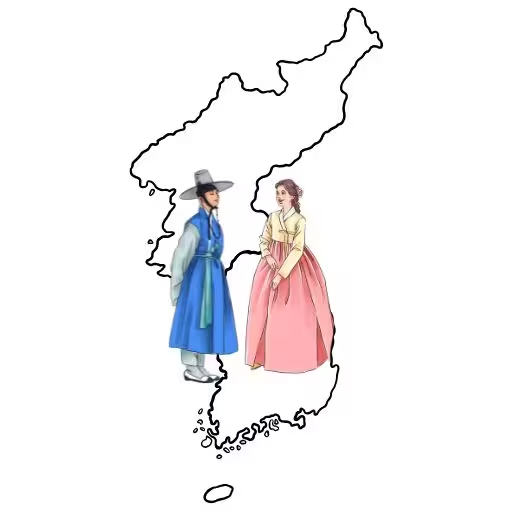Table of Contents
What Are Korean Demonstrative Pronouns?
Korean demonstrative pronouns are important words that help point to specific things or ideas. They are key to how sentences are built and how we communicate clearly, allowing speakers to say exactly what they mean. Words like “this,” “that,” “these,” and “those” in English do basically the same thing.
Types of Korean Demonstrative
Korean demonstrative pronouns are categorized into three primary groups:
- Proximal Korean Demonstrative Pronouns (near the speaker)
- Medial Korean Demonstrative Pronouns (near the listener but not the speaker)
- Distal Korean Demonstrative Pronouns (far from the speaker)
Proximal Korean Demonstrative Pronouns (near the speaker)
이 (I)
- ‘이’ is a Korean demonstrative pronoun that directly translates to this in Korean. It’s used to point to something nearby or to refer to something that’s just been mentioned.
- Understanding this in Korean with ‘이’ is the foundation of learning other Korean demonstrative pronouns, and its effective use is crucial for clear and natural communication. By effectively using this in Korean,” you enhance your ability to point out specific items and objects while communicating.
Example

Original Korean Sentence
A: 이 음식 맛있어요? B: 네, 아주 맛있어요.
Pronunciation Guide
A: 이 (i) 음식 (eum-sik) 맛있어요 (ma-sit-sseo-yo)? B: 네 (ne), 아주 (a-ju) 맛있어요 (ma-sit-sseo-yo).
Meaning and Context
A: 이 (this) 음식 (food) 맛있 (to be delicious) 어요 (is; I’m asking you polite and friendly)? B: 네 (yes; in a formal way), 아주 (very) 맛있 (to be delicious) 어요 (is; I’m telling you polite and friendly).
English Translation
A: Is this food delicious? B: Yes, it’s very delicious.
Literal Translation
A: Is this food delicious? B: Yes, (it)’s very delicious.
이거 (Igeo)
- It’s a combination of “이” (this) and “거” (thing). So, “이거” means “this thing.”
Example
Original Korean Sentence
A: 나 이거 필요해. B: 나도 이거 필요한데.
Pronunciation Guide
A: 나 (na) 이거 (i-geo) 필요해 (pi-ryo-hae). B: 나도 (na-do) 이거 (i-geo) 필요한데 (pi-ryo-han-de).
Meaning and Context
A: 나 (I) 이 (this) 거 (thing; colloquial style of 것) 필요하 (to need) 해 (I’m telling you casually). B: 나 (I) 도 (too) 이 (this) 거 (thing; colloquial style of 것) 필요하 (to need) ㄴ데 (but..).
Pronunciation Patterns for Conjugations
* 하 changes to 해,
* 필요하 + ㄴ데 = 필요한데
When rapidly pronounced, ‘하’ and ‘ㄴ’ naturally combine to form ‘한’.
English Translation
A: I need this. B: I need this too.
Literal Translation
A: I need this thing. B: I need this thing too, but..
여기 (Yeogi)
- It means Here in Korean and is used to refer to the current location or place where you are.
Example
Original Korean Sentence
A: 저기요. 여기가 어디예요? B: 여기는 인천 역 광장이에요.
Pronunciation Guide
A: 저기요 (jeo-gi-yo). 여기가 (yeo-gi-ga) 어디예요 (eo-di-ye-yo)? B: 여기는 (yeo-gi-neun) 인천 (in-cheon) 역 (yeok) 광장이에요 (gwang-jang-i-e-yo).
Meaning and Context
A: 저기요 (excuse me). 여기 (here) 가 (my subject is here) 어디 (where) 예요 (is; I’m asking you polite and friendly)? B: 여기 (here) 는 (as for here) 인천 (In-cheon) 역 (station) 광장 (plaza) 이에요 (is; I’m telling you polite and friendly).
English Translation
A: Excuse me. Where am I? B: This is Incheon Station Plaza.
Literal Translation
A: Excuse me. Where is here? B: As for here, (it) is Incheon Station Plaza.

Want to learn Korean in a simple and structured way, just like this? My courses break down grammar step by step, making Korean easy to understand. Plus, you can try free sample lessons. Ready to start?
Medial Korean Demonstrative Pronouns (near the listener but not the speaker)
그 (Geu)
- This word means “that” in Korean and is used to indicate something a bit farther away than “이” (this).
Example
Original Korean Sentence
A: 그 옷 예뻐요. B: 고마워요. 어제 시장에서 샀어요.
Pronunciation Guide
A: 그 (geu) 옷 (ot) 예뻐요 (ye-bbeo-yo). B: 고마워요 (go-ma-wo-yo). 어제 (eo-je) 시장에서 (si-jang-e-seo) 샀어요 (sat-sseo-yo).
Meaning and Context
A: 그 (that) 옷 (clothes) 예쁘 (to be pretty) 어요 (are; I’m telling you polite and friendly). B: 고맙 (thank you) 어요 (I’m telling you polite and friendly). 어제 (yesterday) 시장 (market) 에서 (at) 사 (to buy) 았 (past tense) 어요 (I’m telling you polite and friendly).
Pronunciation Patterns for Conjugations
* 예쁘 + 어요 = 예뻐요, 고맙 + 어요 = 고마워요, 사 + 았 = 샀
When rapidly pronounced, ‘쁘’ and ‘어’ naturally combine to form ‘뻐’.
When rapidly pronounced, ‘맙’ and ‘어’ naturally combine to form ‘마워’.
When rapidly pronounced, ‘사’ and ‘았’ naturally combine to form ‘샀’.
English Translation
A: Those clothes are pretty. B: Thank you. I bought them at the market yesterday.
Literal Translation
A: That clothes are pretty. B: Thank you. (I) bought (them) at market yesterday.
그거 (Geugeo)
Similar to “이거,” but for something a bit farther away – “that thing.”
Example
Original Korean Sentence
A: 그거 어디에서 샀어? B: 동대문 시장에서 샀어.
Pronunciation Guide
A: 그거 (geu-geo) 어디에서 (eo-di-e-seo) 샀어 (sat-sseo)? B: 동대문 (dong-dae-mun) 시장에서 (si-jang-e-seo) 샀어 (sat-sseo).
Meaning and Context
A: 그 (that) 거 (thing; colloquial style of 것) 어디 (where) 에서 (at) 사 (to buy) 았 (past tense) 어 (I’m asking you casually)? B: 동대문 (a major shopping district and market area in Seoul) 시장 (market) 에서 (at) 사 (to buy) 았 (past tense) 어 (I’m telling you casually).
Pronunciation Patterns for Conjugations
* 사 + 았 = 샀
When rapidly pronounced, ‘사’ and ‘았’ naturally combine to form ‘샀’.
English Translation
A: Where did you buy that? B: I bought it at Dongdaemun Market.
Literal Translation
A: At where did (you) buy that? B: (I) bought (it) at Dongdaemun Market.
거기 (Geogi)
“거기” means “there” in Korean and is used to refer to a location or place that’s somewhat distant from you.
Example
Original Korean Sentence
A: 거기에 가지 마. 위험한 곳이야. B: 알았어요. 안 갈게요.
Pronunciation Guide
A: 거기에 (geo-gi-e) 가지 (ga-ji) 마 (ma). 위험한 (wi-heo-man) 곳이야 (go-si-ya). B: 알았어요 (a-rat-sseo-yo). 안 (an) 갈게요 (gal-gge-yo).
Meaning and Context
A: 거기 (there) 에 (to) 가 (to go) 지 마 (don’t; in a casual way). 위험한 (dangerous) 곳 (place) 이야 (is; I’m telling you casually). B: 알 (to know) 았 (past tense) 어요 (I’m telling you polite and friendly). 안 (not) 가 (to go) ㄹ게 (will) 요 (I’m telling you polite and friendly).
English Translation
A: Don’t go there. It’s a dangerous place. B: I understand. I won’t go.
Literal Translation
A: Don’t go to there. (It)’s dangerous place. B: (I) knew. (I) won’t go.
Distal Korean Demonstrative Pronouns (far from the speaker)
저 (Jeo)
This word is similar to “그” (that) but indicates something even farther away or more distant.
Example
Original Korean Sentence
A: 저 사진 예쁘다. B: 산과 들이 아름다워.
Pronunciation Guide
A: 저 (jeo) 사진 (sa-jin) 예쁘다 (ye-bbeu-da). B: 산과 (san-gwa) 들이 (deu-ri) 아름다워 (a-reum-da-wo).
Meaning and Context
A: 저 (that (over there)) 사진 (photo) 예쁘 (to be pretty) 다 (is; wow). B: 산 (mountain) 과 (and) 들 (field) 이 (my subject is the mountains and fields) 아름답 (to be beautiful) 어 (are; I’m telling you casually).
Pronunciation Patterns for Conjugations
* 아름답 + 어 = 아름다워
When rapidly pronounced, ‘답’ and ‘어’ naturally combine to form ‘다워’.
English Translation
A: That photo is beautiful. B: The mountains and fields are gorgeous.
Literal Translation
A: That photo is pretty. B: Mountain and field are beautiful.
저거 (Jeogeo)
Like the previous two, but for something even more distant – “that thing over there.”
Example
Original Korean Sentence
A: 저거 뭐예요? B: 저거는 시계탑이에요.
Pronunciation Guide
A: 저거 (jeo-geo) 뭐예요 (mwo-ye-yo)? B: 저거는 (jeo-geo-neun) 시계탑이에요 (si-gye-ta-bi-e-yo).
Meaning and Context
A: 저 (that; over there) 거 (thing; colloquial style of 것) 뭐 (what) 예요 (is; I’m asking you polite and friendly)? B: 저 (that; over there) 거 (thing; colloquial style of 것) 는 (as for that) 시계 (clock) 탑 (tower) 이에요 (is; I’m telling you polite and friendly).
English Translation
A: What is that? B: That is a clock tower.
Literal Translation
A: What is that thing (over there)? B: As for That thing (over there), (it) is clock tower.
저기 (Jeogi)
While “거기” (geogi) translates to “there,” it indicates a location within a reasonable distance. However, when something is even farther away, you would use “저기” (jeogi). Think of “저기” as the equivalent of “over there in Korean.”
To really illustrate the difference, imagine pointing to a nearby table and saying “거기” to indicate an item on it. Now, imagine pointing to a distant landmark across a park; you’d naturally say “저기,” meaning ‘over there.’
Mastering this subtle distinction between “거기” and “저기” is crucial for clear and accurate communication when describing locations in Korean, showcasing the nuances built into Korean demonstrative pronouns.
Example
Original Korean Sentence
A: 저기에 뭐가 있어? B: 저기에 가면 강이 있어.
Pronunciation Guide
A: 저기에 (jeo-gi-e) 뭐가 (mwo-ga) 있어 (it-sseo)? B: 저기에 (jeo-gi-e) 가면 (ga-myeon) 강이 (gang-i) 있어 (it-sseo).
Meaning and Context
A: 저기 (over there) 에 (at) 뭐 (what) 가 (my subject is what) 있 (to exist) 어 (I’m asking you casually)? B: 저기 (over there) 에 (to) 가 (to go) 면 (if) 강 (river) 이 (my subject is a river) 있 (there is) 어 (I’m telling you casually).
English Translation
A: What’s over there? B: If you go over there, there’s a river.
Literal Translation
A: What exist at over there? B: If (you) go over there, there’s a river.
Conclusion: Mastering 9 Korean Demonstrative Pronouns
Korean demonstrative pronouns are indispensable components of the language, serving as linguistic signposts that guide communication. By understanding their nuances and practicing their application, you can elevate your proficiency in the Korean language.
Our mission is to equip you with the knowledge and tools needed to navigate the world of Korean demonstrative pronouns with confidence. As you embark on your language-learning journey, remember that mastering these pronouns is a significant step toward fluency and effective communication in Korean.
Sign up for my newsletter and get
📖 Korean short stories
🎧 Listening practice with audio
❓ Vocabulary and grammar quizzes
🎁 Free courses
📝 Blog updates
– all delivered straight to your inbox!









